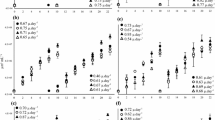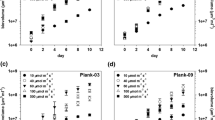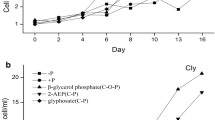Abstract
The hypothesis that outcomes of phosphorus and light competition between Cylindrospermopsis raciborskii and Microcystis aeruginosa are strain dependent was tested experimentally. Critical requirements of phosphorus (P*) and of light (I*) of two strains of each species were determined through monoculture experiments, which indicated a trade-off between species and also between Microcystis strains. Competition experiments between species were performed using the weakest predicted competitors (with the highest values of P* and of I*) and with the strongest predicted competitors (with the lowest values of P* and of I*). Under light limitation, competition between the weakest competitors led C. raciborskii to dominate. Between the strongest competitors, the opposite was observed, M. aeruginosa displaced C. raciborskii, but both strains co-existed in equilibrium. Under phosphate limitation, competition between the weakest competitors led C. raciborskii to exclude M. aeruginosa, and between the strongest competitors, the opposite was observed, M. aeruginosa displaced C. raciborskii, but the system did not reach an equilibrium and both strains were washed out. Hence, outcomes of the competition depended on the pair of competing strains and not only on species or on type of limitation. We concluded that existence of different trade-offs among strains and between species underlie our results showing that C. raciborskii can either dominate or be displaced by M. aeruginosa when exposed to different conditions of light or phosphate limitation.



Similar content being viewed by others
References
Ahn C, Chung A (2002) Diel rhythm of algal phosphate uptake rates in P–limited cyclostats and simulation of its effect on growth and competition. J Phycol 704:695–704
Armstrong RA, McGehee R (1980) Competitive exclusion. Am Nat 115(2):151–170
Bittencourt-Oliveira MC, Oliveira MC, Bolch CJS (2001) Genetic variability of Brazilian strains of the Microcystis aeruginosa complex (Cyanobacteria /Cyanophyceae) using the phycocyanin intergenic spacer and flanking regions (cpcBA). J Phycol 37:810–818
Bolch CJ, Blackburn SI, Jones GJ, Orr PT, Grewe PM (1997) Plasmid content and distribution in Australian isolates of Microcystis Kützing ex Lemmermann (Cyanobacteria: Chroococcales). Phycologia 36:6–11
Bonilla S, Aubriot L, Soares MCS et al (2011) What drives the distribution of the bloom forming cyanobacteria Planktothrix agardhii and Cylindrospermopsis raciborskii? FEMS Microbiol Ecol 79:594–607. doi:10.1111/j.1574-6941.2011.01242.x
Bouvy M, Falcão D, Marinho M, Pagano M, Moura A (2000) Occurrence of Cylindrospermopsis (Cyanobacteria) in 39 Brazilian tropical reservoirs during the 1998 drought. Aquat Microb Ecol 23:13–27
Briand E, Yéprémian C, Humbert J-F, Quiblier C (2008) Competition between microcystin- and non-microcystin-producing Planktothrix agardhii (Cyanobacteria) strains under different environmental conditions. Environ Microbiol 10(12):3337–3348. doi:10.1111/j.1462-2920.2008.01730.x
Briand J-F, Leboulanger C, Humbert J-F et al (2004) Cylindrospermopsis raciborskii (Cyanobacteria) invasion at mid-latitudes: selection, wide physiological tolerance, or global warming? J Phycol 40(2):231–238. doi:10.1111/j.1529-8817.2004.03118.x
Butler GJ, Wolkowicz GSK (1987) Exploitative competition in a chemostat for two complementary, and possibly inhibitory, resources. Math Biosci 48:1–48
Chonudomkul D, Yongmanitchai W, Theeragool G et al (2004) Morphology, genetic diversity, temperature tolerance and toxicity of Cylindrospermopsis raciborskii (Nostocales, Cyanobacteria) strains from Thailand and Japan. FEMS Microbiol Ecol 48(3):345–355. doi:10.1016/j.femsec.2004.02.014
Coles JF, Jones R (2000) Effect of temperature on photosynthesis-light response and growth of four phytoplankton species isolated from a tidal freshwater river. J Phycol 16:7–16. doi:10.1046/j.1529-8817.2000.98219.x
Ducobu H (1998) The ecophysiology of a prochlorophyte and a cyanobacterium with emphasis on phosphorus metabolism. Dissertation, University of Amsterdam. http://dare.uva.nl/pt/record/156924
Ducobu H, Huisman J, Jonker R (1998) Competition between a prochlorophyte and a cyanobacterium under various phosphorus regimes: comparison with the Droop model. J Phycol 34:467–476. doi:10.1046/j.1529-8817.1998.340467.x
Everson S, Fabbro L, Kinnear S, Wright P (2011) Extreme differences in akinete, heterocyte and cylindrospermopsin concentrations with depth in a successive bloom involving Aphanizomenon ovalisporum (Forti) and Cylindrospermopsis raciborskii (Woloszynska) Seenaya and Subba Raju. Harmful Algae 10(3):265–276. doi:10.1016/j.hal.2010.10.006
Falkner G, Wagner F, Falkner R (1996) The bioenergetic coordination of a complex biological system is revealed by its adaptation to changing environmental conditions. Acta Biotheor 44:283–299
Figueredo CC, Giani A (2009) Phytoplankton community in the tropical lake of Lagoa Santa (Brazil): conditions favoring a persistent bloom of Cylindrospermopsis raciborskii. Limnologica 39(4):264–272. doi:10.1016/j.limno.2009.06.009
Figueredo CC, Giani A, Bird DF (2007) Does allelopathy contribute to Cylindrospermopsis raciborskii (Cyanobacteria) bloom occurrence and geographic expansion? J Phycol 43(2):256–265. doi:10.1111/j.1529-8817.2007.00333.x
Flöder S, Jaschinski S, Wells G, Burns CW (2010) Dominance and compensatory growth in phytoplankton communities under salinity stress. J Exp Mar Biol Ecol 395:223–231. doi:10.1016/j.jembe.2010.09.006
Gantar M, Berry JP, Thomas S et al (2008) Allelopathic activity among Cyanobacteria and microalgae isolated from Florida freshwater habitats. FEMS Microbiol Ecol 64(1):55–64. doi:10.1111/j.1574-6941.2008.00439.x
Grossman A, Schaefer M, Chiang G (1994) The responses of cyanobacteria to environmental conditions: light and nutrients. In: Bryant D (ed) The Molecular Biology of Cyanobacteria. Kluwer Acad Publ, Amsterdam, pp 641–675
Gugger M, Molica R, Berre BL (2005) Genetic diversity of Cylindrospermopsis strains (Cyanobacteria) isolated from four continents. Appl Environ Microbiol. doi:10.1128/AEM.71.2.1097-1100.2005
Hamilton PB, Ley LM, Dean S, Pick FR (2005) The occurrence of the cyanobacterium Cylindrospermopsis raciborskii in Constance Lake: an exotic cyanoprokaryote new to Canada. Phycologia 44:17–25
Hoeger SJ, Shaw G, Hitzfeld BC, Dietrich DR (2004) Occurrence and elimination of cyanobacterial toxins in two Australian drinking water treatment plants. Toxicon 43(6):639–649. doi:10.1016/j.toxicon.2004.02.019
Huisman J, Oostveen PV, Weissing FJ (1999) Species dynamics in phytoplankton blooms: incomplete mixing and competition for light. Am Nat 154(1):46–48
Huisman J, Weissing FJ (1994) Light-limited growth and competition for light in well-mixed aquatic environments: an elementary model. Ecology 75:507–520
Huszar VLM, Silva LHS (1999) Cinco décadas de estudos sobre a ecologia do fitoplâncton no Brasil. Limnotemas 2:1–22
Isvánovics V, Shafik HM, Présing M, Juhos S (2000) Growth and phosphate uptake kinetics of the cyanobacterium, Cylindrospermopsis raciborskii (Cyanophyceae) in throughflow cultures. Freshw Biol 43:257–275. doi:10.1046/j.1365-2427.2000.00549.x
Janse I, Kardinaal WEA, Meima M et al (2004) Toxic and nontoxic Microcystis colonies in natural populations can be differentiated on the basis of rRNA gene internal transcribed spacer diversity. Appl Environ Microbiol 70:3979–3987
Kardinaal WEA, Janse I, Agterveld MK et al (2007) Microcystis genotype succession in relation to microcystin concentrations in freshwater lakes. Aquat Microb Ecol 48:1–12. doi:10.3354/ame048001
Kato T, Watanabe MF, Watanabe M (1991) Allozyme divergence in Microcystis (Cyanophyceae) and its taxonomic inference. Algol Stud 64:129–140
Kenesi G, Shafik HM, Kovács AW, Herodek S, Présing M (2009) Effect of nitrogen forms on growth, cell composition and N2 fixation of Cylindrospermopsis raciborskii in phosphorus-limited chemostat cultures. Hydrobiology 623(1):191–202. doi:10.1007/s10750-008-9657-9
Klausmeier CA (2001) Algal games: the vertical distribution of phytoplankton in poorly mixed water columns. Limnol Oceanogr 46(8):1998–2007
Leibold MA (1997) Do nutrient-competition models predict nutrient availabilities in limnetic ecosystems? Oecologia 110(1):132–142
Litchman E (2003) Competition and coexistence of phytoplankton under fluctuating light: experiments with two cyanobacteria. Aquat Microb Ecol 31:241–248
Litchman E, Klausmeier CA, Schofield OM, Falkowski PG (2007) The role of functional traits and trade-offs in structuring phytoplankton communities: scaling from cellular to ecosystem level. Ecol Lett 10(12):1170–1181. doi:10.1111/j.1461-0248.2007.01117.x
Lund JWH, Kipling C, Lecren ED (1958) The inverted microscope method of estimating algal number and statistical basis of estimating by counting. Hydrobiology 11:143–170
Lürling M, Beekman W (2006) Palmelloids formation in Chlamydomonas reinhardtii: defence against rotifer predators? Ann Limnol- Int J Lim 42:65–72. doi:10.1051/limn/2006010
Lürling M, Faassen EJ (2012) Controlling toxic cyanobacteria: effects of dredging and phosphorus-binding clay on cyanobacteria and microcystins. Water Res 46(5):1447–1459. doi:10.1016/j.watres.2011.11.008
Lyck S, Christoffersen K (2003) Microcystin quota, cell division and microcystin net production of precultured Microcystis aeruginosa CYA 228 (Chroococcales, Cyanophyceae) under field conditions. Phycologia 42:667–674
Marinho MM, Azevedo SMF (2007) Influence of N/P ratio on competitive abilities for nitrogen and phosphorus by Microcystis aeruginosa and Aulacoseira distans. Aquat Ecol 41(4):525–533. doi:10.1007/s10452-007-9118-y
Marinho MM, Huszar VL (2002) Nutrient availability and physical conditions as controlling factors of phytoplankton composition and biomass in a tropical reservoir (Southeastern Brazil). Arch Hydrobiol 153(3):443–468
Moisander PH, Ochiai M, Lincoff A (2009) Nutrient limitation of Microcystis aeruginosa in northern California Klamath River reservoirs. Harmful Algae 8(6):889–897. doi:10.1016/j.hal.2009.04.005
Molica RJR, Oliveira EJA, Carvalho PVVC et al (2005) Occurrence of saxitoxins and an anatoxin-a(s)-like anticholinesterase in a Brazilian drinking water supply. Harmful Algae 4(4):743–753. doi:10.1016/j.hal.2004.11.001
Nixdorf B, Mischke U, Rücker J (2003) Phytoplankton assemblages and steady state in deep and shallow eutrophic lakes—an approach to differentiate the habitat properties of Oscillatoriales. Hydrobiology 502(172):111–121
Oberhaus L, Briand J-F, Humbert J-F (2008) Allelopathic growth inhibition by the toxic, bloom-forming cyanobacterium Planktothrix rubescens. FEMS Microbiol Ecol 66(2):243–249. doi:10.1111/j.1574-6941.2008.00567.x
Padisák J, Reynolds CS (1998) Selection of phytoplankton associations in Lake Balaton, Hungary, in response to eutrophication and restoration measures, with special reference to the cyanoprokaryotes. Hydrobiology 384:41–53
Padisák J (1997) Cylindrospermopsis raciborskii (Woloszynska) Seenayya et Subba Raju, an expanding, highly adaptive cyanobacterium: worldwide distribution and review of its ecology. Arch Hydrobiol/Supplement 107:563–593
Paerl HW, Hall NS, Calandrino ES (2011) Controlling harmful cyanobacterial blooms in a world experiencing anthropogenic and climatic-induced change. Sci Total Environ 409(10):1739–1745. doi:10.1016/j.scitotenv.2011.02.001
Paerl HW, Tucker J, Bland PT (1983) Carotenoid enhancement and its role in maintaining blue-green algal (Microcystis aeruginosa) surface blooms. Limnol Oceanogr 28:847–857
Passarge J, Hol S, Escher M, Huisman J (2006) Competition for nutrients and light: stable coexistence, alternative stable states, or competitive exclusion? Ecol Monogr 76(1):57–72
Piccini C, Aubriot L, Fabre A et al (2011) Genetic and eco-physiological differences of South American Cylindrospermopsis raciborskii isolates support the hypothesis of multiple ecotypes. Harmful Algae 10:644–653. doi:10.1016/j.hal.2011.04.016
Raps S, Wyman K, Siegelman HW, Falkowski PG (1983) Adaptation of the Cyanobacterium Microcystis aeruginosa to light intensity. Plant Physiol 72(3):829–832
Repka S, Mehtonen J, Vaitomaa J, Saari L, Sivonen K (2001) Effects of nutrients on growth and nodularin production of Nodularia strain GR8b. Microbial Ecol 42(4):606–613. doi:10.1007/s00248-001-0026-8
Reynolds CS (2006) Ecology of phytoplankton. Cambridge University Press, Cambridge
Rhee GY (1973) A continuous culture study of phosphate uptake, growth rate and polyphosphate in Scenedesmus sp. J Phycol 9:495–506
Rivkin RB, Swift E (1982) Phosphate uptake by the oceanic dinoflagellate Pyrocystis noctiluca. J Phycol 18:113–120. doi:10.1111/j.1529-8817.1982.tb03164.x
Robarts RB, Zohary T (1992) The influence of temperature and light on the upper limit of Microcystis aeruginosa production in a hypertrophic reservoir. J Plankton Res 14(2):235–247
Schwarz R, Forchhammer K (2005) Acclimation of unicellular cyanobacteria to macronutrient deficiency: emergence of a complex network of cellular responses. Microbiology 151:2503–2514. doi:10.1099/mic.0.27883-0
Shen H, Song L (2007) Comparative studies on physiological responses to phosphorus in two phenotypes of bloom-forming Microcystis. Hydrobiology 592(1):475–486. doi:10.1007/s10750-007-0794-3
Smayda T (1997) Harmful algal blooms: their ecophysiology and general relevance to phytoplankton blooms in the sea. Limnol Oceanogr 42(5):1137–1153
Soares MC, Rocha MIA, Marinho MM, Azevedo SMFO, Branco CWC, Huszar VLM (2009) Changes in species composition during annual cyanobacterial dominance in a tropical reservoir: physical factors, nutrients and grazing effects. Aquat Microb Ecol 57:137–149. doi:10.3354/ame01336
Sommer U (1989) The role of competition for resources in phytoplankton succession. In: Sommer U (ed) Plankton ecology: succession in plankton communities. Springer-Verlag, Berlin, pp 57–106
Stewart FM, Levin BR (1973) Partitioning of resources and the outcome of interspecific competition: a model and some general considerations. Am Nat 107:171–198
Stüken A, Rücker J, Endrulat T et al (2006) Distribution of three alien cyanobacterial species (Nostocales) in northeast Germany: Cylindrospermopsis raciborskii, Anabaena bergii and Aphanizomenon aphanizomenoides. Phycologia 45(6):696–703. doi:10.2216/05-58.1
Tilman D (1982) Resource competition and community structure. Princeton University Press Princeton, NJ
Tomioka N, Imai A, Komatsu K (2011) Effect of light availability on Microcystis aeruginosa blooms in shallow hypereutrophic Lake Kasumigaura. J Plankton Res 33(8):1263–1273. doi:10.1093/plankt/fbr020
Tucci A, Sant’Anna CL (2003) Cylindrospermopsis raciborskii ( Woloszynska ) Seenayya &Subba Raju (Cyanobacteria): variação semanal e relações com fatores ambientais em um reservatório eutrófico, São Paulo, SP, Brasil. Rev Bras Bot 2:97–112
Van de Waal DB, Verspagen JM, Finke JF et al (2011) Reversal in competitive dominance of a toxic versus non-toxic cyanobacterium in response to rising CO2. ISME J 5(9):1438–1450. doi:10.1038/ismej.2011.28
Vézie C, Rapala J, Vaitomaa J, Seitsonen J, Sivonen K (2002) Effect of nitrogen and phosphorus on growth of toxic and nontoxic Microcystis strains and on intracellular microcystin concentrations. Microb Ecol 43:443–454. doi:10.1007/s00248-001-0041-9
Via-Ordorika L, Fastner J, Kurmayer R et al (2004) Distribution of microcystin producing and non-microcystin-producing Microcystis sp. in European freshwater bodies: detection of microcystins and microcystin genes in individual colonies. Syst Appl Microbiol 27:592–602
Vidal L, Kruk C (2008) Cylindrospermopsis raciborskii (Cyanobacteria) extends its distribution to Latitude 34°53′S: taxonomical and ecological features in Uruguayan eutrophic lakes. Panama J Aquat Sci 3(2):142–151
Wilson AE, Sarnelle O, Neilan BA, Tim P, Gehringer MM, Hay ME (2005) Genetic variation of the bloom-forming cyanobacterium Microcystis aeruginosa within and among Lakes: implications for Harmful Algal Blooms. App Environ Microbiol 71:6126–6133. doi:10.1128/AEM.71.10.6126
Wilson AE, Wilson WA, Hay ME (2006) Intraspecific variation in growth and morphology of the bloom-forming cyanobacterium Microcystis aeruginosa. App Environ Microbiol 72(11):7386–7389. doi:10.1128/AEM.00834-06
Yoshida M, Yoshida T, Takashima Y, Kondo R, Hiroishi S (2005) Genetic diversity of the toxic cyanobacterium Microcystis in Lake Mikata. Environ Toxicol 20(3):229–234. doi:10.1002/tox.20102
Acknowledgments
We thank W. Beekman-Lukassen, F. Gillissen, I. Paredes, N. Noyma, and J. Beijer for assistance with the experiments. M.B.G.S. PhD scholarship (BEX2834/04-9) and M.M.M. Post-Doc fellowship (BEX1988/08-5) were funded by the Federal Government of Brazil, Ministry of Education, through CAPES (Coordenação de Aperfeiçoamento de Pessoal de Nível Superior, Ministério da Educação). This study was conducted under the flag of the CAPES (Brazil)/Wageningen University (The Netherlands) CAPES-WUR project 004/2008.
Author information
Authors and Affiliations
Corresponding author
Rights and permissions
About this article
Cite this article
Marinho, M.M., Souza, M.B.G. & Lürling, M. Light and Phosphate Competition Between Cylindrospermopsis raciborskii and Microcystis aeruginosa is Strain Dependent. Microb Ecol 66, 479–488 (2013). https://doi.org/10.1007/s00248-013-0232-1
Received:
Accepted:
Published:
Issue Date:
DOI: https://doi.org/10.1007/s00248-013-0232-1




